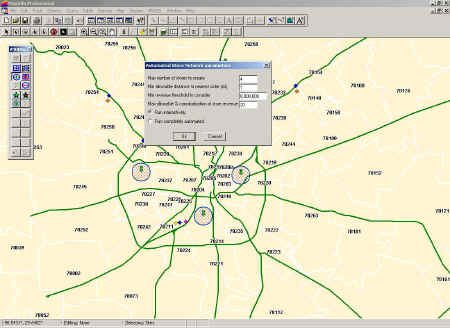Traditionally, site planning has focused on evaluating the sales potential of individual sites before they are built.More recently, however, attention has shifted more towards the evaluation and design of entire site networks. Using detailed research and automated market optimization tools,operators are able to design networks comprised of sites that perform well, both individually and together.These optimal networks attract the most revenue with a minimum of sites, while leaving scant, untapped market potential for the competition.
Also, networks built with different types of sites help assure that maximum market potential can be reached at minimum expense.Large, high overhead sites serve expansive trade areas, while smaller prototypes suit niche populations, small in size and spatial extent.Heavily staffed store formats can be sited to serve consumers who require a high level of customer service, while self-service designs cater to those who prefer making a purchase with little fuss.Additionally, outlets can be selected to best fit the constraints posed by real estate availability and costs.
But while these multiple channels present unique opportunities, they present an even greater set of challenges to those who must plan their deployment.Determining how many units should be placed in a market and where they should be located is a complex issue in itself. When each site can take on a different form, even if this form is limited to a few choices, the planner is presented with a seemingly limitless set of choices for what the ultimate network of sites can become.
Faced with the challenge of planning such a complex network of sites, the following steps are recommended:
(1) Define the goal - While the corporate objective is to maximize profits, the purpose of the retail network and how it contributes to the bottom line may be different.For example, a package shipping company sought to locate sites in order to maximize access to package drop-off points for its customers.In another case, a cellular communications company wanted to optimize its network of retail sites to capture certain types of customers that it was not gaining through other channels.At the same time, they sought to minimize impacts to an existing network of resellers. In both these cases, maximizing site revenue or profitability was not the primary goal as it is with traditional retail operators.If these different goals had not been recognized and defined, and the networks had not been specifically designed to meet them, large capital outlays would have been improperly allocated at best or, worse, the entire retail strategy could have failed.
(2) Know the customers - One of the key advantages of operating multiple site formats and channels is the ability to cater to the unique preferences of varying consumers.Therefore, in order to properly site these different formats it is important to know these consumers and their site preferences. One of the most powerful ways to distinguish different customer types is through lifestyle segmentation systems that categorize households based on demographics, lifestyle, and consumer behavior.Using lifestyle segmentation, profiles of existing customers of the different site formats can be built to understand key differences in the types of customers who patronize the different channels.Most lifestyle segmentation systems are also tied to a wide variety of syndicated survey databases identifying the unique shopping behavior of different consumer types.This makes it possible to make up for a lack of customer data either because it is not collected or it pertains to a channel that does not yet exist.
(3) Understand the constraints - The types of possible site location opportunities can vary among channels.Some channels can have the utmost flexibility in determining location while others may be constrained to very specific location types.Still others may have no flexibility, such as when a company with existing locations partners with another to open store-in-store facilities or sell product directly off its own shelves. Understanding these constraints is an important way to prevent untenable network plans and to simplify the planning process.A greetings card company, for example, was able to design a network by first identifying supermarket and mass merchandiser partners to sell through, then identifying traditional malls to put stores into, and finally targeting those few remaining areas where stores were needed to cover residual gaps in its market coverage.
(4) Recognize synergies - Since, there is generally a great deal of overlap in the types of customers served by the different channels, it may be possible to develop a partnership with an existing operator of retail sites rather than develop a new site concept from the ground up.This can result in significant savings in development costs and time-to-market. A nutritional supplements company which operates an extensive network of sites, for example, was able to increase business with seniors through partnerships with drug stores at a fraction of the cost required to further expand its own network.With the data and methodologies available today, it is possible to understand such synergies without the existing sites, which have been generally considered necessary in order to generate customer and performance data for such research.
(5) Create a flexible tool (see image below) - When looking at ways
to evaluate and create site network plans and scenarios, be it a research
methodology or an automated market optimization system, it is important
to maintain maximum flexibility.No methodology or system can completely
consider the large number of confounding factors, such as real estate availability,
that enter into the development equation between the time networks are
planned and real estate secured.And a change in one recommended site can
affect decisions regarding all the other sites in a market. With
multiple channels, the possibility of these factors changing or negating
a network plan increases.For this reason, it is critical that the tool
developed to facilitate network planning provide the ability to change
and entertain what-if scenarios on a continual basis.
